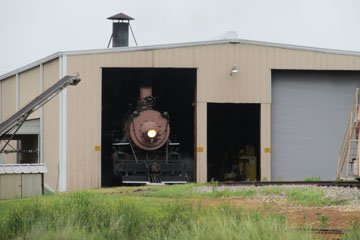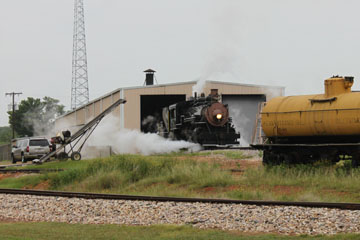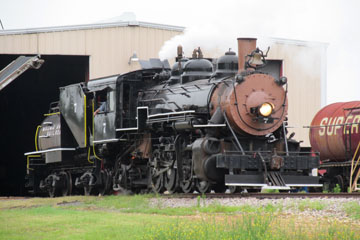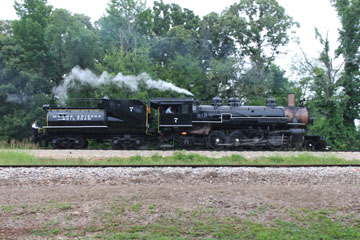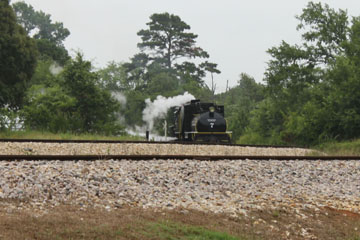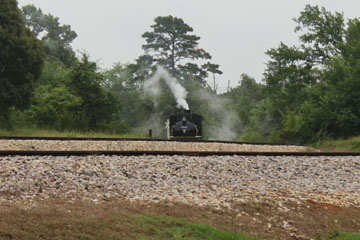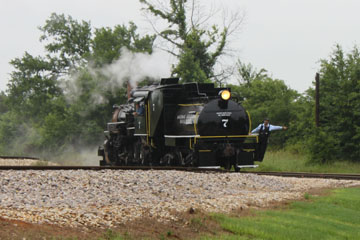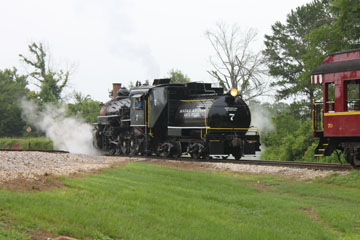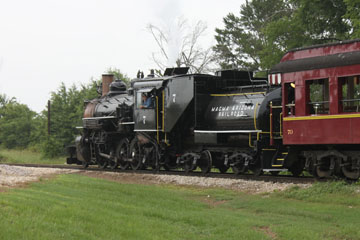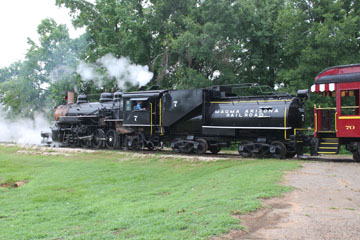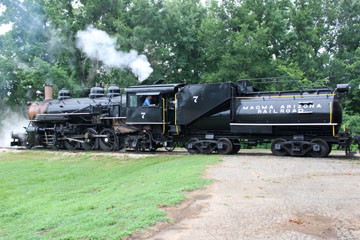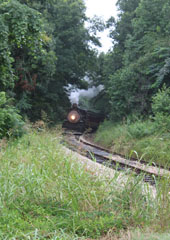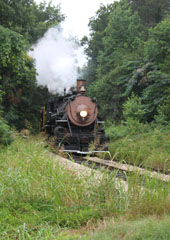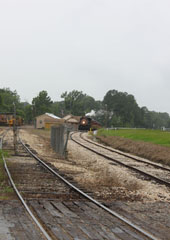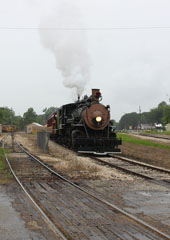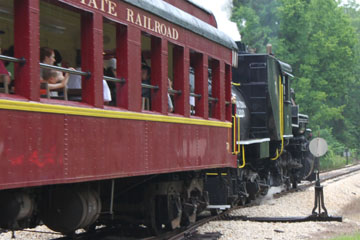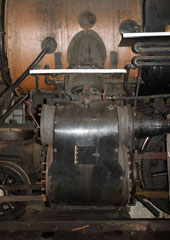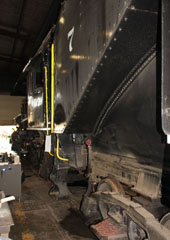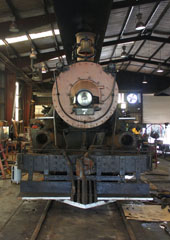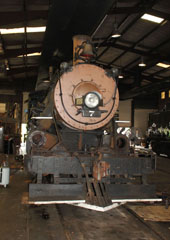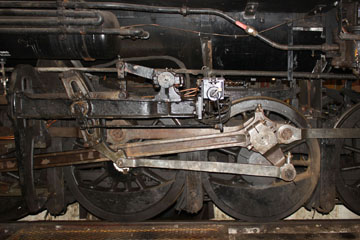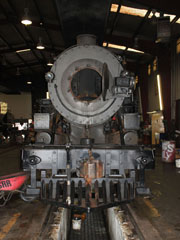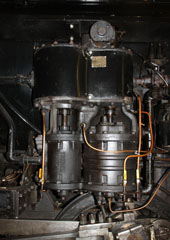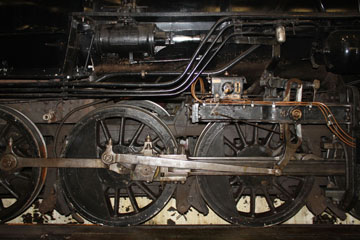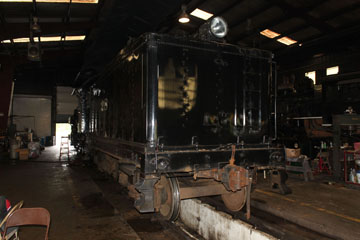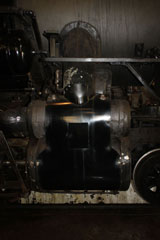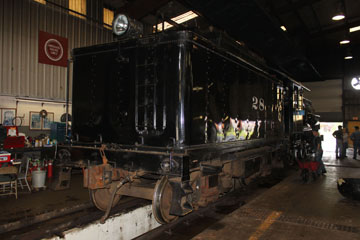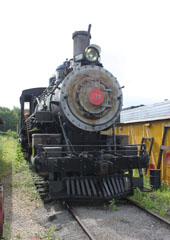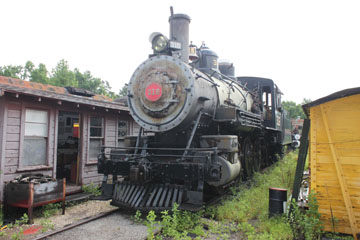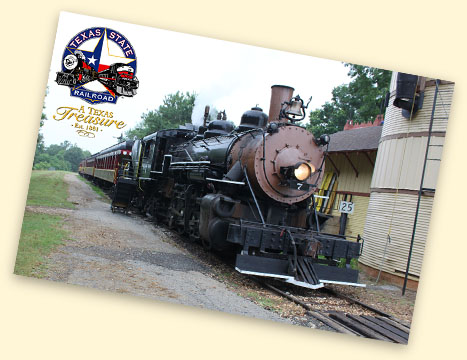

The Texas State Railroad is a twenty-five mile line running between Rusk and Palestine, TX.
The railroad was started as a narrow gauge line by the state of Texas in 1881 to bring raw materials and fuel to the Rusk Penitentiary iron smelter, and to take finished products out. Built by prison inmates, it was extended to Maydelle in 1906 and to Palestine in 1909. It was later converted to standard gauge and expanded to freight and passenger service but remained unprofitable, with regular service ending in 1921.
The line was then leased to the Texas & New Orleans Railroad until 1962 and then to the Texas South-Eastern until 1969. After failure of the shortlived Cherokee & Southwestern Tourist Railroad to establish a tourist operation under a new lease, in 1972, the line was turned over to the Texas Parks and Wildlife Department to be used as a state park. Prison inmates once again worked to help clear brush along the right of way.
The line reopened on 25th June 1976 but still failed to stack up financially: by 2006, the operation was costing the state $1 million per year more to maintain and operate than the park revenue generated.

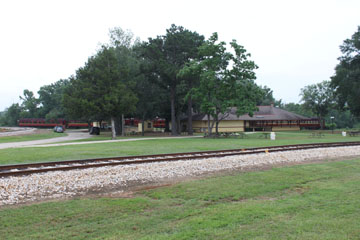
Top, the depot at Rusk. Lower photo, the depot at Palestine.
In 2007, the railroad was transferred to the Texas State Railroad Authority who leased the operation to American Heritage Railway, which also operated the Durango & Silverton Narrow Gauge Railroad in Colorado and the Great Smoky Mountains Railroad in North Carolina. In 2012, American Heritage sold the concern to Iowa Pacific Holdings which, in addition to continuing passenger services, began offering freight services. The railroad has four operational steam locomotives and two diesel-electrics, as well as one locomotive on static display.

When we visited, Magma Arizona #7 was at the head of a morning excursion from Palestine to Rusk. A Mikado type (2-8-2) locomotive, it was built at a cost of $29,500 in 1917 by the Baldwin Locomotive Works in Philadelphia, PA, as #30 for the Tremont & Gulf Railway in Tremont, LA.
In 1899, the family of William Joyce bought land in Louisiana, established the Tremont Lumber Company and built a saw mill at Tremont, LA, to process timber on the land. It was soon apparent that some form of transport was needed to carry timber from stands of pine to the mill.
Above, running south on one arm of the wye at Palestine.
The Tremont & Gulf was chartered in August 1902, and the first thirty mile section of line opened from Tremont to Dally, LA, in July 1903. Subsequent sections opened and, by 1908, when the company reorganised after foreclosure as the Tremont & Gulf Railway, it rostered eight steam locomotives operating over sixty-one miles of rail.
#30 arrived on the T&G a few months after the US entered WWI. Built as a coal burner, it was converted to oil in 1923 when it was mated to a Vanderbilt tender holding 6,500 gallons of water and 2,400 gallons of oil.
#7 has an engine wheelbase of 30’ 7” and driver wheelbase of 14’ 6”, Walschaert valve gear and
21” x 26” cylinders. The engine weighs 182,500 lbs, 140,000 lbs on its 54” drivers. With a 41.5 sq ft grate, 163 sq ft firebox and total heating surface of 2,817 sq ft, including 518 sq ft superheating, it operates at a boiler pressure of 200 psi delivering 36,097 lbs tractive effort.
#30 was sold in 1954 to the Magma Arizona Railroad where it was renumbered #7. It worked at the MA's copper mines until its last run on 10th June 1967.
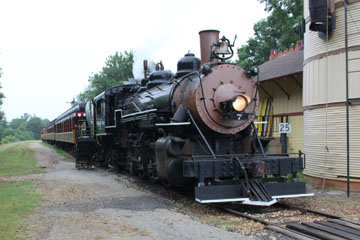
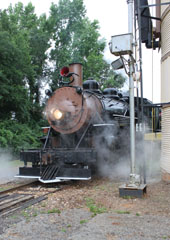
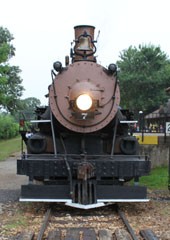
Above, #7 standing in the depot. Before the train leaves, passengers have an opportunity to climb up into the cab.
The Texas State Railroad bought the engine in 1974 and volunteers restored it to operating condition in 1978 and renumbered it #400. The two original sand domes and steam dome have collars at their bases and tops more in keeping with 19th Century engines, and the copper coloured smokebox is actually how it appeared when it worked on the Magma Arizona.
Since 1977, the Texas State Railroad has been used for many movies, television shows, documentaries, commercials and video shoots.

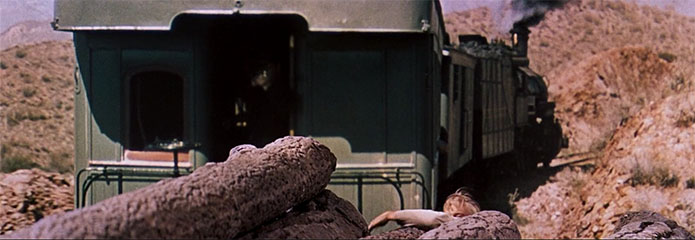
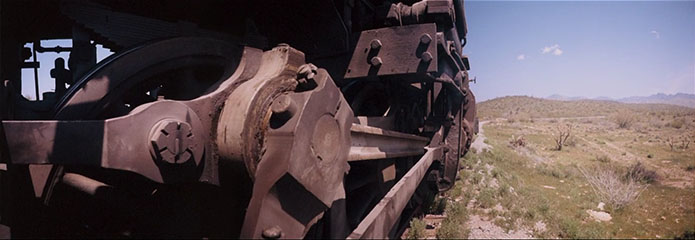
Above, three frames showing #7 featuring in the closing scenes of the MGM Panavision movie How the West Was Won.
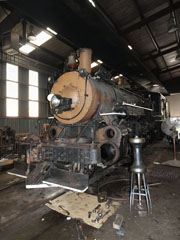
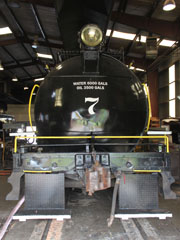
By previous arrangement, the park regularly offers tours of the maintenance shops in Rusk, as well as in Palestine, where you can see Texas & Pacific Texas type (2-10-4) locomotive #610.
Built by the Lima Locomotive Works in 1927, #610 hauled the "American Freedom" Train for the portion of its tour in Texas in 1976.

This Consolidation type (2-8-0) locomotive was one of about fifteen hundred of the type built by Baldwin for the US Army from 1916 to 1918. They were known as "Pershings", after four-star General John Pershing, Commander of the US Expeditionary Forces in Europe.
The 166,400 lb locomotive has 56" drivers and
21" x 28" cylinders. A coal burner, it has a 41 sq ft grate, 128 sq ft firebox and 2,236 sq ft total heating surface, including 471 sq ft superheating. Operating at a boiler pressure of 190 psi, #101 delivered 35,610 lbs tractive effort.
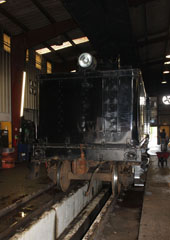
Built as #645, the locomotive was renumbered #20 at Camp Claiborne, LA, in 1941 and, six years later, was sold to a private owner. It was later sold on to the Tremont & Gulf Railway in Winnfield, LA, and renumbered #28, then to the Temple Lumber Co., in Pineland, TX, in 1955, later the Southern Pine Lumber Co. It was sold to the Texas State Railroad in 1976, where it was initially numbered #300. It was restored to its original SPL livery and number in 1915.
You can see another surviving "Pershing" locomotive on the National Railroad Museum page of this website.

#316 is one of sixty-six D-9 Class Ten Wheeler
type (4-6-0) locomotives built in 1901 by the
Cooke Locomotive Works in Paterson, NJ, for the Texas & Pacific Railway. Built for freight service,
it is the oldest locomotive in the railroad's collection, and is the only operable surviving T&P engine.
With a 23' 4" engine wheelbase and 12' 8" driver wheelbase, it weighs 158,000 lbs, 122,000 lbs on its 63" drivers. It has Walschaert valve gear and
20" x 26" cylinders. The grate is 35 sq ft, the
firebox 192 sq ft and total heating surface is 2,147 sq ft. An oil burner, it operated at a boiler
pressure of 200 psi, delivering 28,063 lbs tractive effort. The tender weighs 122,000 lbs light and has a capacity of 2,800 gallons of water and 6,500 gallons of water.
In 1949, the T&P sold #316 to the Paris & Mt. Pleasant Railroad, a T&P subsidiary. With the help of an anonymous female benefactor, in 1951, the T&P then donated the locomotive to the City of Abilene. It was displayed in the Oscar Rose Park for many years, wearing number #75 to symbolise the 75th Jubilee Celebration of the City. In 1974, it was donated to the Texas State Railroad.
The engine was refurbished and unveiled in October 2006 and has been used for steam excursions at the railroad.


